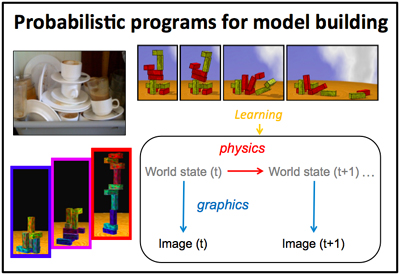Tutorial 5: Church Programming
tutor5.jpg
Description:
Josh Tenenbaum and colleagues propose that our intuitions about properties like the stability of a stack of blocks, may derive from “probabilistic programs” that can simulate, with some uncertainty, the physics that governs how objects behave in space and time. Such programs can be implemented and tested using probabilistic programming languages such as the Church language.
file
82 kB
tutor5.jpg
Alt text:
Diagram with photos of three types of stacked objects—dishes in a sink, stable tower of blocks and collapsing unstable tower of blocks.
Caption:
Josh Tenenbaum and colleagues propose that our intuitions about properties like the stability of a stack of blocks, may derive from “probabilistic programs” that can simulate, with some uncertainty, the physics that governs how objects behave in space and time. Such programs can be implemented and tested using probabilistic programming languages such as the Church language.

Course Info
Instructors
Departments
As Taught In
Summer
2015
Level
Topics
Learning Resource Types
theaters
Other Video
theaters
Lecture Videos
notes
Lecture Notes
group_work
Projects
Instructor Insights









